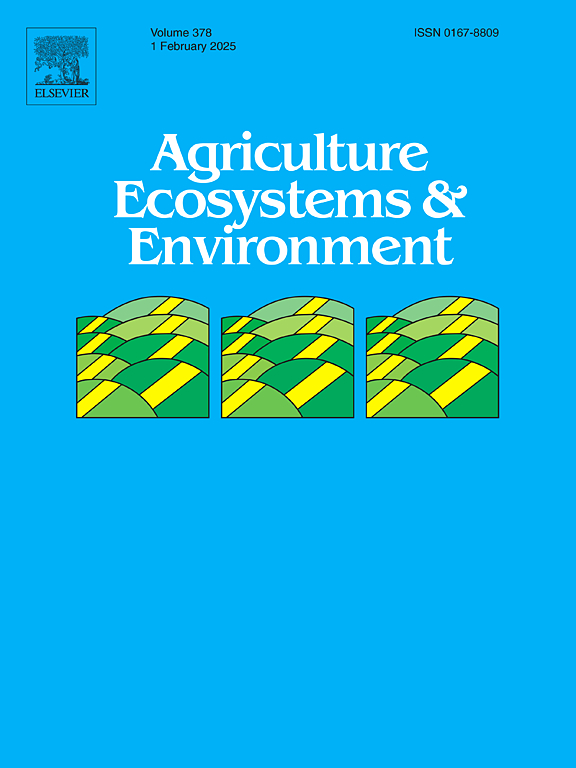Traditional and industrial approaches to oil palm cultivation alter the biodiversity of ground-dwelling arthropods in Liberia (West Africa)
IF 6
1区 农林科学
Q1 AGRICULTURE, MULTIDISCIPLINARY
引用次数: 0
Abstract
Oil palm cultivation is vital to global food security and economically important to farmers. However, the rapid expansion of oil palm plantations has caused large-scale deforestation in the tropics and, consequently, biodiversity loss and changes in ecosystem functioning. Oil palm is primarily cultivated in Southeast Asia, where the ecological impacts of production have been studied extensively. It is also grown in West Africa, using traditional and industrial methods of cultivation. However, in comparison to Southeast Asia, relatively little research on the impacts of oil palm cultivation in West Africa has occurred. Working in the framework of the Sustainable Oil Palm in West Africa (SOPWA) Project (Sinoe County, Liberia), we investigated differences in the biodiversity of ground-dwelling arthropods across rainforest (the regional natural habitat) and oil palm systems cultivated under traditional (called “country palm”) and industrial management. We sampled arthropods with pitfall traps (160 retrieved) across 54 monitoring plots in rainforest, country palm, and industrial oil palm. We found no differences in total arthropod abundance across systems, but we did find changes in arthropod order-level community composition, driven by differences in the relative abundance of Araneae, Collembola, Dermaptera, and Diptera. We conducted focused morphospecies-level analyses on spiders, owing to their key roles as predators within tropical agricultural systems, and to determine if our order-level findings held true at increased taxonomic resolution. Our spider analyses indicated that country palm supported the greatest number of spider individuals and species, and that all systems supported distinct spider assemblages. Our findings have implications for both arthropod conservation and oil palm productivity, owing to the important ecosystem functions (e.g., pest control) that many arthropods provide. Future research should investigate whether changes in on-farm management practices influence arthropod communities – and the ecosystem functions they support – in West Africa.
油棕种植的传统和工业方法改变了利比里亚(西非)地栖节肢动物的生物多样性
油棕种植对全球粮食安全至关重要,对农民具有重要的经济意义。然而,油棕种植园的迅速扩张造成了热带地区大规模的森林砍伐,从而导致生物多样性的丧失和生态系统功能的变化。油棕主要种植在东南亚,其生产对生态的影响已被广泛研究。西非也有种植,采用传统和工业的种植方法。然而,与东南亚相比,对西非油棕种植影响的研究相对较少。在西非可持续油棕(SOPWA)项目(利比里亚Sinoe县)的框架下,我们调查了在传统(称为“乡村棕榈”)和工业管理下种植的热带雨林(区域自然栖息地)和油棕系统中地面生活节肢动物的生物多样性差异。我们在热带雨林、乡村棕榈和工业油棕的54个监测样地使用陷阱对节肢动物进行了采样(检索到160种)。在不同的系统中,节肢动物的总丰度没有差异,但节肢动物的群落组成发生了变化,这是由蜘蛛目、弹尾目、皮翅目和双翅目的相对丰度差异所驱动的。由于蜘蛛在热带农业系统中作为捕食者的关键角色,我们对蜘蛛进行了集中的形态和物种水平的分析,并确定我们的目级发现是否在更高的分类学分辨率下成立。分析结果表明,棕地的蜘蛛个体和种类数量最多,且各系统的蜘蛛种群数量各不相同。由于节肢动物提供了重要的生态系统功能(如害虫控制),我们的研究结果对节肢动物保护和油棕生产力都有影响。未来的研究应该调查西非农场管理实践的变化是否会影响节肢动物群落及其支持的生态系统功能。
本文章由计算机程序翻译,如有差异,请以英文原文为准。
求助全文
约1分钟内获得全文
求助全文
来源期刊

Agriculture, Ecosystems & Environment
环境科学-环境科学
CiteScore
11.70
自引率
9.10%
发文量
392
审稿时长
26 days
期刊介绍:
Agriculture, Ecosystems and Environment publishes scientific articles dealing with the interface between agroecosystems and the natural environment, specifically how agriculture influences the environment and how changes in that environment impact agroecosystems. Preference is given to papers from experimental and observational research at the field, system or landscape level, from studies that enhance our understanding of processes using data-based biophysical modelling, and papers that bridge scientific disciplines and integrate knowledge. All papers should be placed in an international or wide comparative context.
 求助内容:
求助内容: 应助结果提醒方式:
应助结果提醒方式:


